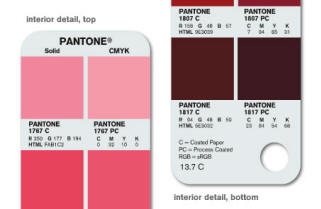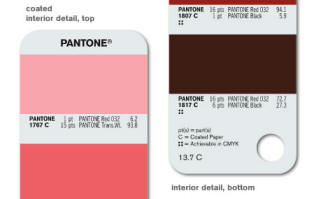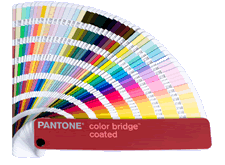There are a few ways people commonly choose a colour for digital output:
- Pantone
- HSB / HLS
- CIE/LAB
Pantone
Most people are familiar with Pantone colours, although don’t usually realise this does not specify what colour is expected from a final printed result.
Pantone only describes the colour of the ink used by offset presses. The final printed offset colour may even vary depending on different stock used. See Pantone’s official web site in our links page.
Pantone works for a set of 14 base colours (not including specialties such as fluorescent or metallic inks) and many people can better compare it to mixing paint at the hardware store. A base is used and then tints are added in specific amounts to mix the pantone colours.

Ink digital printing (referred to “Process” in offset terminology) you are only working with 3 colours (cyan, magenta, and yellow) with black for shade. So it’s impossible to exactly match every single offset colour in the Pantone Coated/Uncoated guides. Depending on the colour gamut of the ink and media combination in your digital printer, you will produce different amounts of pantone colours, and without careful calibration and profiling of your printer, you will battle to often get PMS colours on your digital printer (however, once again, with careful calibration and profiling of the printer you will have the best automatic match to the pantone sets).

The Pantone Coated guide (as an example – seen right) shows what result could typically be expected from an offset coated stock when approved pantone inks are used to mix each swatch in the book. But remember, even in offset, when you print these inks onto different papers you will get a different finished colour. People comparing pantone colours to a digital printer should use the “Pantone Bridge” guide (seen above), as this gives examples of both the coated and process (CMYK) expected results, and also gives RGB values under the coated swatches.
Other processes that don’t use these 14 colours to produce Pantone colour (like ALL digital printers) are just a representation of that offset ink system.

There is an article that I produced for the Visual Impact magazine that talks in more depth on this topic in the Reference tab.
Compare Pantone products online at cielab colourshop
HSB / HLS
You may have seen HSB (Hue, Saturation & Brightness) or HLS (Hue, Lightness & Saturation).
These models were created, and are used by the graphic art industry as they’re more intuitive way to discuss colour.
CieLab
A better method for describing colour scientifically is a system called CieLab.
This was created by the “International Colour Consortium” (ICC) and is based on 3 dimensional numerical values representing how the average human eye sees colour. See the ICC web site in our links page. There is a more advanced explanation on our What is Cielab page.
Just because we can describe a colour does not mean that the output device can accurately reproduce it.
Sorry, the comment form is closed at this time.